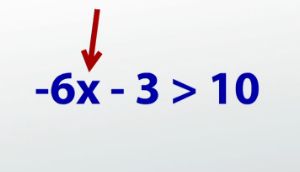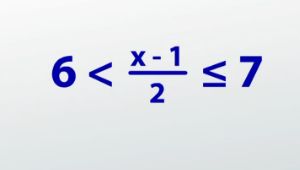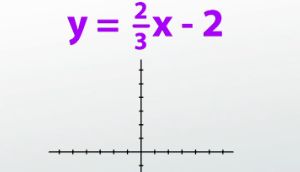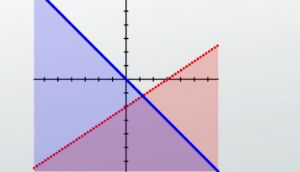Graphing Inequalities: Practice Problems
After you watch the video and know the material, click HERE for the quiz.
If you're already pretty familiar with what inequalities are and just looking for a place to practice your skills, this is the place. This lesson covers topics like 1-variable, 2-variable, compound, and systems of inequalities.
I'm a really big fan of trying to teach the 'why' behind the 'how' when it comes to math, and I try to do this as much as I can. Knowing the 'why' can really help cut down on the things you have to memorize and make the work much simpler. But at a certain point you still need to say 'what do I do,' and practice some problems. That's what this lesson is all about. We'll quickly go through four examples so that you can start to get comfortable with the types of questions you might see about inequalities.
I welcome you to pause the video as soon as I introduce any of the four examples and try to do the problem on your own to see how well you do. And then, watch my work to compare how you did with what I did, see if you did it a different way, or maybe, see where your mistake was. By going through the example first, yourself, you can oftentimes cut to the chase on what are the specific things you need verses trying to learn the whole thing when maybe you already know most of it.
Practice Problem #1
Here we go. Our first example:
Solve and graph the inequality -6x - 3 > 10
This is a 1-variable inequality because there is only one letter x, and it is not a compound inequality because there is only one greater than or less than symbol. This means we can simply use inverse operations to get the x by itself and do our graph when we're done.
 |
I can begin by taking off the outer most layer -3 with a +3. Now the outermost layer is times by -6. I undo multiplication with division. Dividing both sides by -6 gives me a fraction on the right-hand side, which is okay: -13/6. I now must also remember the golden rule about inequalities that is we must flip the inequality symbol when we divide or multiple both sides by a negative number. Therefore, the solved inequality I get is x < - 13/6.
Now we're ready to graph. Because this is a 1-variable inequality, I put my graph on a number line. I find my way over to -13/6, which is about -2.17. I put an open circle there - I don't fill it in - because it is just less than, not or equal to. I draw an arrow going to the left to indicate all the numbers that are smaller than this are allowed.
Practice Problem #2
On to example two:
Solve and graph the inequality 6 < (x - 1) / 2 <_ 7
We've got another 1-variable inequality here, but it is now a compound inequality because there are two greater than or less than symbols. This example is an AND compound inequality because the variable is sandwiched in between two values, which tells me that my answer, my graph, should look something like this. We will still use inverse operations to get the x by itself, but because there are two inequality symbols, we'll have to do two problems in one.
 |
There are two methods to do this. So, it can get confusing to do two problems in one. So, there are two methods to do this. In one we split the inequality up into two separate inequalities and solve each individually. In one that's going to be a little bit faster where we leave it as a compound inequality and do both problems at once. I'll show both ways (one on one side and one on the other), and you can decide which you like more.
It's up to us to get the x by itself. I have to use inverse operations to undo whatever's being done. Looking at the expression with the x in it, the most outside layer is divide by 2, which means I have to multiply by 2 to undo that. In the long way, where we split it up, I can simply multiple by 2 on both sides in both inequalities. You end up with this. But you see on the method where I'm doing both sides at once, I can express all that in one line, and I end up with a very similar statement. Now the only operation to undo is -1. I undo subtraction with addition. I add 1 to both sides, and no matter which method you are using, you end up with 13 < x <_ 15.
Now that we've solved the compound inequality, we can graph it by doing one piece at a time. I can start by putting x > 13 on the graph by putting an open circle at 13 because it's just greater than not equal to and drawing an arrow to the right to indicate all the values that are bigger. I can put x >_ 15 by putting a closed circle, a filled-in circle, at 15 to indicate that it could be or equal to and an arrow going to the left to indicate that it's all the values that are smaller than that. Because this is an AND inequality, I need both things to be true, which means the only solutions are the ones where both graphs are, where they overlap.
Practice Problem #3
On to example three:
Graph 2x - 3y > 6
This is our first 2-variable inequality question because we've got xs and ys. Although we need to indicate on our graph where 2 x - 3y > 6 , we first need to find the boundary line between the greater than and less than regions. This boundary line right in between greater than and less than is where 2x - 3y = 6. So, we can first use our linear equation graphing skills to plot this line.
Because this line is in standard form, we could use the intercept method, which is a shortcut, to substitute in zeros for x and y to find the corresponding points, put those points on our graph, connect them to find our line, but I've found that most students would rather put the question into slope intercept form and go from there.
In order to use this slope intercept method, we first have to get the y by itself using inverse operations. Undoing the 2x and undoing the -3 in front of the y gives us our slope intercept form of this equation:' y = 2/3x - 2. The slope intercept form of our equation tells us that -2 is our y-intercept. It's our beginning value. So, I go down to -2 on our graph and put a point. Next, I use the slope to tell me to go up 2, over 3 to find our next point, and I connect my two points to get my line: y = 2/3x - 2.
 |
Just to point out that the shortcut intercept method would have worked, realize that the two points we found in that shortcut are these exact two same points that we graphed here. So, either way works.
Now that we have the boundary line drawn where 2x - 3y = 6, we need to find the area of the graph where 2x - 3y > 6. To figure out which side of the boundary is the greater than side, we can substitute in a test point and see if it works. 0,0 is often the easiest one to try, so plugging that into our original inequality gives us 2(0) - 3(0) and we want to check - Is that greater than 6? Simplifying the expression down gives us the statement that 0 > 6, which is, obviously, not true. Therefore, that means the side of the line that 0,0 is on is not the greater than side, but it is the less than side. Which means that all the points above the line are where 2x - 3y < 6. Because we want the greater than side, that means that our answer is not above the line, but below it. The area where 2x - 3y > 6 is everything below the line we drew earlier. Lastly, noticing that our inequality was strictly greater than and not equal to, we need to change our boundary line to a dotted line to indicate that it is not part of our solution.
Practice Problem #4
For our last example, let's simply add more 2-variable inequalities to the last problem and turn it into a system of inequalities:
Graph 2x - 3y > 6 and y <_ -x and y > -3
Since we already know what the first inequality looks like (it looks just like our last problem), we can start with that one on our graph. But now, because there are multiple inequalities in one problem, we need to put the other ones on the same set of axis as this one. We can simply do one at a time.
Let's start with our second one: y <_ -x. This is already in slope intercept form, although it may not really look like it as y <_ -1x + 0. That means I can begin the graph at 0, go down one over one, connect the dots, and I end up with the line, like so. To find out which side to shade we need to test a point, but our typical tester the origin 0,0 is out because it's right on the line, so it's not going to tell us much useful information. You could pick any other point you want. Doesn't matter as long as it's not on the line, as long as it's obviously on one side or the other, but I'll go with 2,2.
Substituting in 2,2 into the inequality y <_ -x gives us the statement 2 <_ -2, which is not true. Therefore the side of the line that 2,2 is on is not the side we want to shade, and we shade everything below it. We now have to remember that we are graphing a system of inequalities, which means our answer is only the area where the shading from both inequalities intersect. This means that so far our answer is only the triangular region underneath both lines.
We can now lastly add in our last inequality, y > -3. The type of inequality in this problem can be deceiving because there's only one variable, but when the problem gives us restrictions on y, it implies that x can be whatever we want. This means we continue with the normal method and graph the boundary line, y = -3.
 |
Y equals lines in a coordinate plane are horizontal lines at the value it states, so this line is simply a left and right line directly at -3. We can still substitute in a value to see if it works, and 0,0 is valid again because it isn't on the boundary. Since we don't care about what x is, simply putting in 0 for y gives us the statement 0 > -3. This time that's true, so the 0,0 side of the y = -3 line is the side we want. We shade everything above this line.
We have to remember to make it a dotted line when it is strictly greater than, so we can go ahead and erase little bits of the line to make this a dotted line. Finally, taking into account that it's a system of inequalities, our solution is, again, only the region where this new shading intersects the shading from the previous two inequalities. Erasing all the areas where this new shading is by itself and only leaving the areas where this new shading intersects the others, gives us our final answer as the small triangular region that is above the y equals line, but below both diagonal lines. Any x,y coordinates found in this region will make any of the three additional inequalities true if you plug in the points.
Lesson Summary
To review:
- When solving inequalities, you must flip the sign any time you multiply or divide both sides by a negative number.
- The graphs of 1-variable inequalities go on a number line and look something like this.
- The graphs of 2-variable inequalities go on coordinate planes and look something like this.
- All systems of 2-variable inequalities are AND problems, which mean the solutions are only the regions of the graphs that overlap.